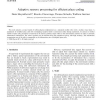Free Online Productivity Tools
i2Speak
i2Symbol
i2OCR
iTex2Img
iWeb2Print
iWeb2Shot
i2Type
iPdf2Split
iPdf2Merge
i2Bopomofo
i2Arabic
i2Style
i2Image
i2PDF
iLatex2Rtf
Sci2ools
IJON
2006
2006
Adaptive sensory processing for efficient place coding
This work presents a neural model of self-localisation implemented on a simulated mobile robot with a realistic visual input. A population of modelled place cells with overlapping receptive fields is constructed online during exploration. In contrast to similar models of place cells, parameters of neurons in the sensory pathway adapt online to the environments statistics in order to maximise information transmission. The robot's position can be decoded from the population activity with high accuracy. The information transmission rate of the cells is comparable to the information rate of biological place cells. r 2006 Elsevier B.V. All rights reserved.
Related Content
| Added | 13 Dec 2010 |
| Updated | 13 Dec 2010 |
| Type | Journal |
| Year | 2006 |
| Where | IJON |
| Authors | Denis Sheynikhovich, Ricardo Chavarriaga, Thomas Strösslin, Wulfram Gerstner |
Comments (0)

